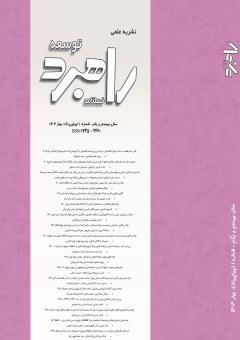عارضهیابی صنایع كوچك و متوسط با استفاده از مدل CSCMP و اولویت بندی آنها با روشAHP
محورهای موضوعی : Economic
امیر حجری
1
,
ناصر فقهی فرهمند
2
*
,
مرتضی هنرمند عظیمی
3
![]()
1 - دانشجوی گروه مدیریت، واحد تبریز، دانشگاه آزاد اسلامی، تبریز، ایران
2 - دانشیار گروه مدیریت، واحد تبریز، دانشگاه آزاد اسلامی، تبریز، ایران
3 - استادیارگروه مدیریت، واحد تبریز، دانشگاه آزاد اسلامی، تبریز، ایران
کلید واژه: صنایع کوچک, صنایع متوسط, اولویت بندی AHP,
چکیده مقاله :
هدف این تحقیق عارضهیابی صنایع کوچک و متوسط كفش و چرم استان آذربایجان شرقی با استفاده از مدل CSCMPو اولویت بندی آنها با روشAHP است. این تحقیق از نظر هدف كاربردی و از نظر روش انجام تحقیق، توصیفی مبتنی بر پیمایش بوده و از نظر روش بررسی، تحلیلی-ریاضی میباشد. در این تحقیق جامعه آماری مربوط به شناسایی عارضههای صنایع كفش و چرم، 92 نفر از کارشناسان و خبرههای صاحب نظر و مدیران صنعت مذكور میباشد. در این تحقیق ابزار سنجش و اندازه گیری متغیرها، دو نوع پرسشنامه محقق ساخته بوده است که یکی از آنها برای شناسایی عارضههای صنایع كفش و چرم و پرسشنامه دیگر نیز جهت اولویت بندی عارضهها بوده است. جهت تجزیه و تحلیل دادههای این تحقیق از روش آمار توصیفی، تحلیل عاملی، متن كاوی، مدل CSCMP و روش AHP استفاده شده است. بر اساس نتایج بدست آمده، 113 عارضه بر اساس سطح شدت كه شامل غیر عارضه، خفیف، مهم، بسیار مهم، شدید شناسایی شدند به طوری كه، 20 درصد عارضههای شناسایی شده ( 22 مورد ) دارای وزن " شدید " و 27 درصد نیز ( 30 مورد ) دارای وزن " بسیار مهم" را به خود اختصاص دادهاند كه نشانگر وجود 47 درصد عارضههای موثر در سرنوشت صنایع چرم و كفش میباشد. همچنین در یک نوع دستهبندی، عارضههای داخلی 72 درصد و عارضههای خارجی 28 درصد آنها را تشكیل میدهند. همچنین 92 درصد عارضههای مربوط به قوانین و مقررارت و 81 درصد عارضهها مربوط به عوامل سیاسی و سیاستهای صنعتی دولت، 70 درصد كنترل و تضمین كیفیت جزو عارضههای بحرانی بودند.
The aim of this research is to identify the complications of small and medium shoe and leather industries in East Azerbaijan province using the CSCMP model and their prioritization with the AHP method. This research is descriptive based on survey in terms of practical purpose and in terms of research method, and analytical-mathematical in terms of research method. In this research, the statistical population related to the identification of complications in the shoe and leather industries is 92 experts and experts and managers of the mentioned industry. In this research, two types of questionnaires were made by the researcher to measure and measure the variables, one of which was for identifying the complications of the shoe and leather industries and the other questionnaire was for prioritizing the complications. To analyze the data of this research, descriptive statistics, factor analysis, text mining, CSCMP model and AHP method were used. Based on the results, 113 complications were identified based on the level of severity, including non-complication, mild, important, very important, and severe, so that 20% of the identified complications (22 cases) have "severe" weight and 27% also (30 cases) have been assigned a "very important" weight, which indicates the existence of 47% of the complications affecting the fate of the leather and shoe industries. Also, in a category, internal complications make up 72% and external complications make up 28% of them. Also, 92% of complications related to laws and regulations, 81% of complications related to political factors and industrial policies of the government, 70% of quality control and assurance were critical complications.
منابع:
- ابراهیمزاده پیلهورد، امیر (1399). تحلیل، عارضهیابی و بهبود فرایندها (مطالعه موردی: شرکت خودروسازی سایپا). پایان نامه کارشناسی ارشد، دانشکده مهندسی صنایع، دانشگاه صنعتی شریف.
- ایزدی، علی. (1399). طراحی یک مدل عارضهیابی زنجیره تامین و پیاده سازی آن در شرکت پارس بهین سیستم. پایان نامه کارشناسی ارشد. دانشکده مهندسی صنایع. دانشگاه صنعتی شریف.
- سایت اتاق صمت ایران، 1401.
- Beamon, B. M. (2019). Measuring supply chain performance. International Journal of Operations & Production Management , 19(3), 275-292.
- Chan F.T.S. Performance Measurement in a Supply Chain. International Journal of Advanced Manufacturing Technology , Vol. 21, (2011), 534–548.
- Chow, G., Heaver, T. D., & Henriksson, L. E. (2018). Logistics performance: definition and measurement. International Journal of Physical Distribution & Logistics Management , 24(1), 17-28.
- Liang L, Yang F, Cook W.D, Zhu J. DEA models for supply chain efficiency evaluation. Annals of Operations Research , Vol. 145, (2016), 3.
- Min, H., Thakkar, J., Kanda, A., & Deshmukh, S. (2011). Supply chain performance measurement framework for small and medium scale enterprises. Benchmarking: An International Journal , 16(5), 702-723.

